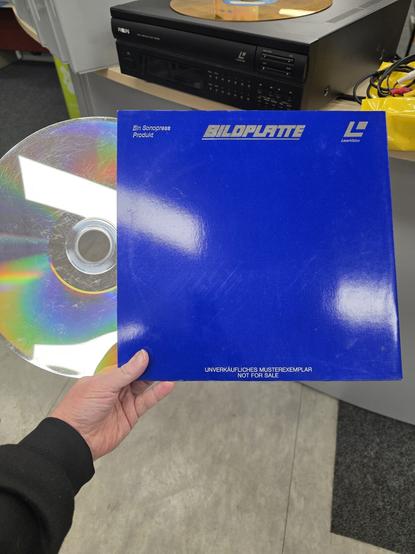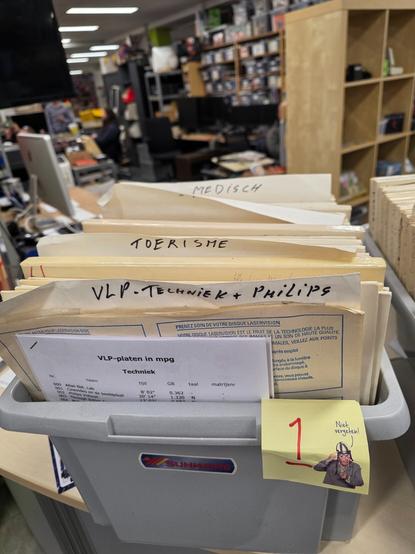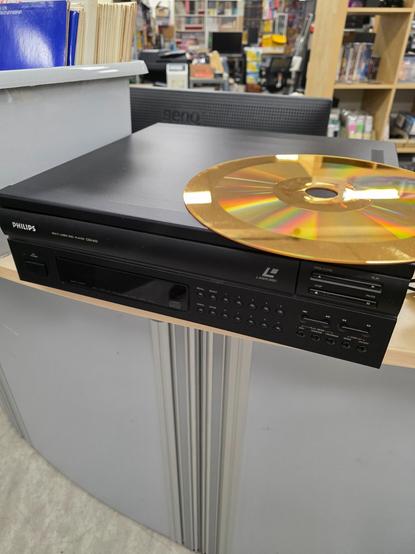Bert Smith, a chemist involved in Laserdisc development, shared fascinating stories about the challenges Philips faced. He explained how the high-quality digital sound on Laserdiscs led to the creation of the CD. The process took 10 years to perfect, with many mistakes along the way, including air bubbles in the glue. We received prototype disks, including a gold half-disk and a transparent layer. There were even plans for a Laserdisc jukebox! We archived it all! Did you have a Laserdisc?
@homecomputermuseum Never had a player, I think I have some discs stashed between my vinyl LPs :) There was also CD-video which is an interesting format but didn't get very big either AFAIK.
@homecomputermuseum Not any more. But I had a Pioneer CLD-D925 and about 60 discs for many years. 🥰
@homecomputermuseum I have one LaserDisc! Two episodes of Star Trek The Next Generation, it’s framed and hanging on my home office wall
@homecomputermuseum The University my Mum studied at had one in the library - she'd leave me there to watch discs and read books while she went to her lectures.
@homecomputermuseum Back in '93 or so, made a CD-ROM to control a LaserDisc from HyperCard -- that's got to be some sort of bingo.
@nonnihil
Can you elaborate the technical details? This is highly relevant to my interests!
@homecomputermuseum
Can you elaborate the technical details? This is highly relevant to my interests!
@homecomputermuseum
@magnetic_tape @homecomputermuseum Alas, it was 30 years ago and I've forgotten most of it.
But... W. W. Norton (not the more famous Norton!) wanted an ancillary CD-ROM to ship with textbooks that would let a lecturer show images from a laserdisc in their lectures. Many laserdisc players of the time had serial port controls that spoke, uh, I think it was the same protocol as IRDA? Or maybe SonyIR? Maybe for wired remote controls or auxiliary receivers? Anyway, if you could find XCMDs for hypercard that spoke serial (I think maybe in the Dartmouth XCMD collection?), you could attach your computer via an ADB-to-serial (or was it geoport to serial?) connector.
This was all part of a product called Norton Presentation Maker, but IIRC didn't make it into the final version because the use case was too niche and the configuration too fiddly.
But... W. W. Norton (not the more famous Norton!) wanted an ancillary CD-ROM to ship with textbooks that would let a lecturer show images from a laserdisc in their lectures. Many laserdisc players of the time had serial port controls that spoke, uh, I think it was the same protocol as IRDA? Or maybe SonyIR? Maybe for wired remote controls or auxiliary receivers? Anyway, if you could find XCMDs for hypercard that spoke serial (I think maybe in the Dartmouth XCMD collection?), you could attach your computer via an ADB-to-serial (or was it geoport to serial?) connector.
This was all part of a product called Norton Presentation Maker, but IIRC didn't make it into the final version because the use case was too niche and the configuration too fiddly.
@nonnihil
Many thanks for this pointer! I have a LD-V8000 with a serial port that is dying to be used. The cable could could be ADB (or localtalk?) to serial as I remember using one few years ago and also got a MIDI adapter for my SE/30 which use one of the ports in the back.
@homecomputermuseum
Many thanks for this pointer! I have a LD-V8000 with a serial port that is dying to be used. The cable could could be ADB (or localtalk?) to serial as I remember using one few years ago and also got a MIDI adapter for my SE/30 which use one of the ports in the back.
@homecomputermuseum
@homecomputermuseum I *do* have an LD player and about 30-40 discs, mostly films and japanese anime.
@homecomputermuseum still do
@homecomputermuseum Those early glue problems are fascinating to me! I remember the early MCA Discovision discs had defect rates approaching 100%.
@homecomputermuseum unfortunately LDs were not backwards compatible with LPs.
@th @homecomputermuseum you could also not play your LPs on a laserdisc player. So sad.
@homecomputermuseum no, only rich people had them
@spacehobo @homecomputermuseum I clicked on this post expecting it to be about the BBC Micro
but, i guess, close enough
but, i guess, close enough
@dan @homecomputermuseum And YOU get an Electron! And YOU get an Electron!
@homecomputermuseum Oh wow!
@homecomputermuseum Yes I have one right now as it happens, though it's not in perfect working order. I'm able to neither replace it nor to fix, so I'm a bit stuck.
@homecomputermuseum What someone in 1979 imagined a laser disc might look like.
@homecomputermuseum I still have about 40 discs, and a Pioneer CLD-M403 machine - I have played them in a couple of years thou, I probably should hook it up and check it out thou.
@kd8bxp @homecomputermuseum I first saw a laser disk played in 1987.
@homecomputermuseum @codinghorror
I never did get a player, but I do still have the 20th anniversary Star Wars laserdiscs, un-opened.
I never did get a player, but I do still have the 20th anniversary Star Wars laserdiscs, un-opened.
Still do, but i need to repair the front loading mechanism. Plastic part broke.
@homecomputermuseum Pioneer did end up making a LaserDisc Jukebox! https://youtu.be/TCvrirk5GFg
Pioneer LaserJuke , LaserDisc Jukebox
@homecomputermuseum
Still have a LD-V8000 and a CLD-A100" Laseractive" !
Still have a LD-V8000 and a CLD-A100" Laseractive" !


